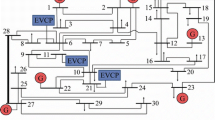Abstract
Vehicle-to-grid (V2G) model is very potential and it has been developed for Hybrid Electric Vehicle (HEV) implementation largely. A modified V2G control model has established and different kinds of renewable energy sources, idle time of vehicles, and generation of power have been taken into consideration simultaneously as per the day schedule of the user of vehicle. Vehicle-to-grid technology is controlled by kee** the relation with the desired state of charge of battery and plug-in material detection. In this paper, the proposed model is implemented and represented by MATLAB. In this paper, we have researched that how to shave the house load with the help of vehicle-to-grid technology. Our main objective is to use the vehicle-to-grid concept to optimize transportation and supply electric power by converting electric cars into power plants virtually. Our aim is also to erect the V2G technology as a scientific method to reduce the peak load and this reduction of peak load is very much essential for smart grids.
Access this chapter
Tax calculation will be finalised at checkout
Purchases are for personal use only
Similar content being viewed by others
References
Turker H, Colak I (2020) Optimal peak shaving with vehicles-to-grid capability of electrical vehicles in smart grids. In: 7th International conference on renewable energy research and applications, Paris-France. https://doi.org/10.1109/ICRERA.2018.8566962
Vuille LF, Kuhn D (2017) A review of the state of research on vehicle-to-grid (V2G) progress and barriers to deployment. In: European battery, hybrid and fuel cell electrical vehicle congress. Geneva. https://doi.org/10.17226/21725
Gupta A, Bansal HO, Jaiswal P, Kumar R (2020) Modelling and analysis of V2G scheme: a concept on smart grid. In: 2020 International conference on emerging trends in communication, control and computing (ICONC3), MODY University of Science and Technology, Laksmangarh. https://doi.org/10.1109/ICONC345789.2020.9117408
Krajcar S, Mescarj P (2015) Home demand-side management of integrated with electric vehicles and renewable energy sources. Energy Build 108:1–9. https://doi.org/10.1016/j.enbuild.2015.09.001
Pani P, Athreya AR, Bansal HO (2019) Integration of vehicle-to-grid (V2G) technology. In: National conference on emerging trends of technology. California. https://doi.org/10.1109/EnergyEconomics.2015.7235108
Guo Y, **ong J, Xu S, Su W (2016) Two-stage economic operation of microgrid-like electric vehicle parking deck. In: 2016 IEEE/PES Transmission and distribution conference and exposition (T&D), Dallas, TX. https://doi.org/10.1109/TSG.2015.2424912
Xue Y, Yu XE, Sirouspour S (2012) Microgrid and transportation electrification. In: IEEE transportation electrification conference and expo (ITEC). https://doi.org/10.1109/ITEC.2012.6243464
Shi L, Lv T, Wang Y (2019) Vehicle-to-grid (V2G) service management logic and formulation. J Mod Power Syst Clean Energy 7(4):935–947. https://doi.org/10.1007/s40565-018-0464-7
Su W, Wang J, Roh J (2014) Stochastic energy scheduling in microgrids with intermittent renewable energy resources. IEEE Trans Smart Grid 5(4):1876–1883. https://doi.org/10.1109/TSG.2013.2280645
Tushar W, Yuen C, Huang S, Smith DB, Poor HV (2016) Cost minimization of charging stations with Photovoltaics: an approach with EV classification. IEEE Trans Intell Transp Syst 17(1):156–169. https://doi.org/10.1109/TTIS.2015.2462824
Wi YM, Lee JU, Joo SK (2013) Electric vehicle charging method for smart homes/buildings with a photovoltaic system. IEEE Trans Consum Electron Field 59(2):323–328. https://doi.org/10.1109/TCE.2013.6531113
Chen C, Duan S, Cai T, Liu B, Hu G (2011) Smart energy management system for optimal microgrid economic operation. IET Renew Power Gener 5(3):258–267
Montoya M, Sherick R, Haralson P, Neal R, Yinger R (2013) Islands in the storm: integrating microgrids into the larger grid. IEEE Power Energy Mag 11(4):33–39
Washom B et al. (2013) Ivory tower of power: microgrid implementation at the University of California, San Diego. IEEE Power Energy Mag 11(4):28–32
Bakre A, Kumar P, Pandita S (2019) Technical study of electric vehicles and charging infrastructure. E&Y Publications, p 24
Seethapathy R, Ghatikar R, Ahuja A (2017) Implementation plan for electrification of public transport in Kolkata, p 32
Chen TD, Kockelman KM, Khan M (2013) The electric vehicle charging station location problem: a parking-based assignment method for Seattle. In: 92nd Annual meeting transportation research board, vol 340, pp 13–1254. Supervisory control, vol 3, Dec 2019
He X, Ding CH, Simon HD (2005) On the equivalence of nonnegative matrix factorization and spectral clustering, in SDM. In: Proceedings of the 2005 SIAM international conference on data mining, vol 5, pp 606–610
Chen WY, Song Y, Bai H, Lin CJ, Chang EY (2011) Parallel spectral clustering in distributed systems. IEEE Trans Pattern Anal Mach Intell 33(3):568–586
Ng AY, Jordan MI, Weiss Y (2002) On spectral clustering: analysis and an algorithm. Adv Neural Inf Process Syst 2:849–856
Martin CH (2012) Spectral clustering: a quick overview. Retrieved from https://charlesmartin14.wordpress.com/2012/10/09/spectralclustering/. Accessed on 05 Jan 2017
Press WH (2007) Numerical recipes 3rd edition: the art of scientific computing. Cambridge University Press
Huang ZK, Chau KW (2008) A new image thresholding method based on Gaussian mixture model. Appl Math Comput 205(2):899–907
Kim SC, Kang TJ (2007) Texture classification and segmentation using wavelet packet frame and Gaussian mixture model. Pattern Recogn 40(4):1207–1221
Reynolds DA, Quatiere TF, Dunn RB (2000) Speaker verification using adapted Gaussian mixture models. Digit Signal Process 10(1):19–41
Catalbus MC, Yildirim M, Issever D, Gulten A, Kurum H (2016) An approach to adaptive structuring element size selection for feature extraction. Int J Comput Sci Inf Secur
Author information
Authors and Affiliations
Corresponding author
Editor information
Editors and Affiliations
Copyright information
© 2023 The Author(s), under exclusive license to Springer Nature Singapore Pte Ltd.
About this paper
Cite this paper
Banerjee, S. et al. (2023). Analysis of Electric Vehicle-To-Grid (V2G) Simulation Model and Optimal Peak Shaving in Smart Grids. In: Szymanski, J.R., Chanda, C.K., Mondal, P.K., Khan, K.A. (eds) Energy Systems, Drives and Automations. ESDA 2021. Lecture Notes in Electrical Engineering, vol 1057. Springer, Singapore. https://doi.org/10.1007/978-981-99-3691-5_11
Download citation
DOI: https://doi.org/10.1007/978-981-99-3691-5_11
Published:
Publisher Name: Springer, Singapore
Print ISBN: 978-981-99-3690-8
Online ISBN: 978-981-99-3691-5
eBook Packages: EnergyEnergy (R0)




